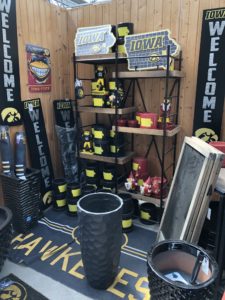
Hiring in Retail
Qualities to Look for in Retail Associates and Managers
So, what exactly should you look for when hiring retail employees? According to experts, you’ll want to keep an eye out for individuals who are (or have):
- Willing and eager to learn
- Patient
- Comfortable with people
- Competitive
- Team-oriented
- Emphatic
- Can-do attitudes
- High emotional intelligence
- Passion for the brand and its products
It’s a tall order, but many of these traits go hand-in-hand, so finding people who exhibit a handful of these attitudes may not be as difficult as you think.
Top talent should be a priority for all retailers. Having outstanding people on your team can help you sell more products, be more efficient, and most important, serve customers better.
So how do you find these top performers? To answer that, we looked into other companies’ hiring practices and talked to retail experts who’ve shared solid advice on finding, attracting and hiring great people for your store.
1. Hire for attitude and train for skill.
We’ve given this advice before, but it’s worth repeating, because it truly is one of the most important pieces of hiring advice that you can get. Nearly all of the experts who weighed in for this article emphasized the importance of looking for people with the right attitudes.
“Take a tip from James Timpson: don’t look at CVs or resumes; hire on the basis of attitude, enthusiasm and energy. Skills can be taught; attitude can’t,” says Andrew Busby, founder and CEO at Retail Reflections, a retail consulting firm.
Cyrenna Dewhurst, a store manager candidate at Dollar General, echoes this advice and says that she once hired a candidate who, despite not having retail experience, had a great attitude.
“I hired a woman once that had zero retail experience,” she says. “She had been in the cleaning business. I just loved her attitude — she was just amazing and even had the best reasons why she would be better at this job than anyone else. She tailored her resume towards why her cleaning business would make her who I would hire.
“Long story short, I hired and trained her to become my strongest ASM. She had integrity and a willingness to learn. So refreshing! She’s running a store herself now, too.”
2. Go beyond traditional interviews.
Now that you’ve identified the traits that you should look for when hiring, how do you surface these qualities in your candidates? People tend to put their best foot forward during formal interviews, so it can be tricky to determine whether or not someone truly has the right attitudes.
A good way around this is to go beyond the traditional interview process. Here are some ideas:
- Take a Walk on the Sales Floor
“One lesson for stores is don’t confine your interviews to the office,” says retail executive Don Uselmann. He recommends that merchants bring the candidates to the sales floor and watch how they interact with department managers and employees.
Bill O’Malley, managing partner of Connector Team Recruiting, echoes this advice.
“You can tell a lot about people as they walk a retail building with you. How do they relate as they walk the floor? How do they engage with people? Do they smile? Are they polite?
Try to have a hiring manager at the store level speak to every applicant. I have made, seen and witnessed many great hires that were made because the hiring authority took the time to meet someone at the counter or in the store.”
- Conduct Group Interviews
There’s a reason why companies like Jet Blue and Disney are able to consistently hire top-notch employees: these companies know how to find individuals who are naturally great with people.
One of the ways to do this is by conducting group interviews. Job applicants at the Disney Store have shared experiences with group interviews in which they were quizzed on their Disney knowledge and were asked to sell something to the rest of the team.
Conducting group interviews makes sense, particularly in customer-facing retail roles. You can gain insights into someone’s people skills by observing how they act around other people, and that can give you a better understanding of how they’ll fit with your team.
- Role Play Retail Situations
Brian Drescher, a former retail operations and category manager in the retail grocery and specialty industries, says he has his team engage with interviewees as if they were customers.
“You learn quite a bit and get to see if they were friendly or standoffish,” he says. “If we were unable to get them to engage in conversation on the sales floor, it could be a sign that they may not bode well with what we were trying to do. Either way, I could learn more about the candidate and I’d be able to address any issues specifically during the interview process.”
Another approach to this is to have actual customers involved in the process. Jenny Salles, a supervisor at Kohl’s, says that she once teamed up with a loyal customer to engage with an applicant to see how they dealt with a real-time situation.
“I coached our customer to hang around the applicant and appear kind of confused about what their needs were,” she says. “The applicant was relaxed and didn’t appear to be intimidated by having a stranger talk to them. The customer finally asked a direct question about a particular product. The applicant admitted to not possessing a great deal of knowledge about said product, but continued to engage in a friendly manner and even took the time out to read the label for the customer.”
Jenny says that she “was impressed with this encounter” and “appreciated that the applicant was not afraid or too proud to ask someone for help.”
- Get Multiple Perspectives
Business consultant Amanda Taylor advises recruiters to get multiple perspectives when vetting an applicant. She says this can be done by “creating an interviewing team. Usually, this will be composed of the people this candidate will be interacting with the most. Ensure everyone on the team has interviewing training. Agree on what questions each person on the team will ask ahead of time.”
She adds, “Have your team conduct individual interviews instead of a panel interview. I’m a big fan of having an open discussion as a group to discuss the interview results of each candidate.”
- Make the Interview a Conversation
Don’t let your interviews be too scripted. Guide questions are okay, but don’t be afraid to have a real conversation and let the other party do most of the talking.
“You will be surprised what you can learn about a person,” Taylor says. “Ask a question to start the conversation, then listen, and continue to ask probing questions to their response.
“Ask the candidate what questions they have for you,” she says. “The questions that a candidate asks on their own will tell you a lot about their attitude, their thought process, and their priorities much more than their rehearsed answers to your interview script.”
3. Hire your biggest fans.
“Look for candidates who display a passion for your brand,” advises Jacqueline Young-Sterling, the Director of Customer Experience at software company Compliant IA.
“Brand ambassadors are influential — your customers will notice! Plus, onboarding will be easier as they are likely already familiar with your company culture and product line.”
One example of a retailer doing this is the vape shop Good Guy Vapes. Owner Shoaib Iqbal shares that they regularly hire existing customers as their employees. In fact, when they decided to expand their business, their first hire was one of their patrons.
“Our first employee was a customer and we’ve continued that tradition ever since. We mostly hire enthusiastic customers.”
See if you can go down the same route in your business. If you’re looking for new staff members, get in touch with customers and fans and see if they’re interested in working for you.
4. Beef up your online presence.
Top performers always do their research, so you want to make sure they like what they see when they Google your company. See to it that your website and social accounts look presentable and contain adequate information about your business.
If you haven’t done so yet, complete your company profile on Glassdoor.com, adding photos and providing as many details as you can. Also, read the reviews that your employees (both past and current) have about your business. If you see some unfavorable reviews, talk to your staff about them and see what you can do.
It’s best to resolve any internal issues first before taking on new hires. The last thing you want is to bring in someone new when there are unresolved issues and politicking involved. The more at peace your company is on the inside, the more attractive it’ll look to applicants and the greater the chances that they’ll stay.
5. Be a multi-channel recruiter.
Retailers of today are operating in a competitive space that requires forward thinking as well as online and social savviness. If you want to attract applicants who have those traits, you should take your recruitment efforts beyond traditional channels such as job boards.
Social media is known to be an effective recruitment tool. LinkedIn, for instance, has a number of talent solutions that enable you to find, vet and contact candidates.
While not specifically made for recruiting, Facebook and Twitter can also help you find new hires. Use Twitter to spread the word about your openings and put a special careers tab on your Facebook page where your fans can browse and apply for jobs.
Even Instagram has proven to be a good platform, particularly for companies looking for young and fresh talent. A study by the Pew Research Center found that the largest group of Instagram users — 67% — is made up of 18- to 29-year-olds. This makes it an ideal platform to attract youthful applicants.
So make it a point to spruce up your employer profile on social media. A good way to do this is to share fun team photos on platforms like Facebook and Instagram. And if you’re actively recruiting, spread the word by posting “We’re hiring” images on your accounts.
And don’t forget about mobile. An increasing number of users are now using their mobile devices to access job boards and look for career information, so make sure your posts and listings are optimized for the small screen.
6. Establish a rubric for employee performance.
“One of the most effective ways retailers can attract and retain the best people is to develop a rubric for employee performance,” says Christine Guillot, founder at small business consulting firm Merchant Method.
“It’s a transparent tool for establishing performance expectations and can be used throughout a person’s employment — from interview through promotion,” Guillot says. “This clarity also provides a consistent framework for both store owners and employees, which is helpful for teams of all sizes.”
If you haven’t done so yet, develop rules of conduct or procedures or employees, document them, for easy reference when hiring and evaluating your team.
7. Be realistic about the job.
Painting an accurate picture of your company and the position will enable both you and the applicant to determine if they’re a good fit for the job. So while it may be tempting to only gush about the good things about your store, don’t oversell the job or misrepresent your company. Be forthcoming about the demands of the position and what your expectations are.
According to business consultant Amanda Taylor, “This is especially true if you are a small business owner or are in a rapid-growth phase and the person in this position will have to wear multiple hats, work long hours and the only thing that is constant is change. Be honest and transparent about any challenges the candidate might face in the position.”
8. Motivate your current employees.
Incentivize your staff to help you recruit more employees. “Your current employees know what it takes to do the job,” says sales consultant, author, and speaker Barry Maherf. “They have a vested interest in bringing in people who will make the workload lighter, not heavier.
“And since, as the cliché goes, birds of a feather stick together, they are very likely to know others who are much like them. Which is why you should take the recommending employee into consideration when considering the person they’re suggesting.”
9. Consider past employees.
Still having trouble finding the best fit? Retail expert Georganne Bender recommends turning to your previous employees to see if they’re looking to come back.
“One of the best sources for new employees is past good employees,” she says. “Studies show that 20 to 25% of employees return because the grass isn’t always greener on the other side, so if you’ve had good performers leave, give them a call and ask if they have ever considered coming back. Even if they say no, they’ll feel good because you thought to call.”
10. Don’t rush the process.
Finally, recognize that when it comes to hiring employees, getting it done right is better than getting it done fast. Don’t settle for a candidate who isn’t perfect for the job just because you want to get the process over with.
“Only hire the best and ensure they are the right fit for you,” Taylor says. “It takes time and patience, but you will be greatly rewarded when you have the right butts in the right seats!”


















 Videos
Videos





